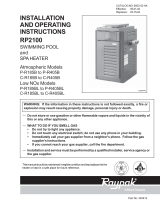15
Troubleshooting
DIAGNOSTIC ERROR CODES AND TROUBLESHOOTING PROCEDURES FOR EF100T399 MODELS WITH
HONEYWELL LOW FIRE START CONTROL SYSTEM
Error Code Definition of Code Cause of Problem and Actions Taken to Correct
No code –
blank display
x Check power supply to the water heater.
x Make sure water heater is plugged in and the breaker is on.
x Check if there is 120 volts power supply to the LINE connections on the
control board.
x If 120 volts is present, check for 24 volts output to SECONDARY
terminals on the Control Board.
x Check for loose wires, defective transformer.
x Check wire harness connections from display to the control board.
3-48, 58-60 Internal Faults
x Verify wiring to the control board with wiring diagram.
x Check power supply to make sure voltage and frequency is correct.
x Check for 24 volts from the transformer to the control board.
x Reset module by interrupting power or pressing the reset button on the
module.
49 Voltage too low or high
x Measure the incoming line voltage.
x Voltage should be 115-125 volts.
x If the voltage is not within this range or there is drastic fluctuation, then
have the incoming power supply checked.
x If the line voltage is satisfactory, check the output from the transformer
to make sure it is 22-26 volts.
x Replace transformer or wiring if defective.
53
AC Inputs phase
reversed
x Check the module and display connections.
x Check the module power supply and make sure that frequency, voltage
and VA capacity of the transformer meet specifications.
x Check to make sure the wiring connections on the control module from
terminals J4-10 and J8-2 are connected together.
62 Fan speed not proved
x Check the blower modulation wire harness connection from the blower
to the control module at J2 connection.
x Make sure the pin terminals make solid contact.
x Measure the resistance of each wire in the wire harness from the
terminal ends.
x Replace wire harness if defective.
x Check if there is 17-30 volts DC between the yellow and green wires on
the blower 5 wire harness.
x Check if there is 17-30 VDC between the yellow and green wires on the
blower 5 wire harness.
67 ILK Off (Interlock Off)
x Check wiring to the normally closed blocked vent safety.
x Use a voltmeter to find out if the blocked vent safety switch has
opened.
x If so, determine the cause (blocked vent terminal, recirculation).
x If limit switch is closed, check wiring for shorts.
x Measure continuity.
x If limit switch and wiring check O.K., replace control module.
Troubleshooting




















